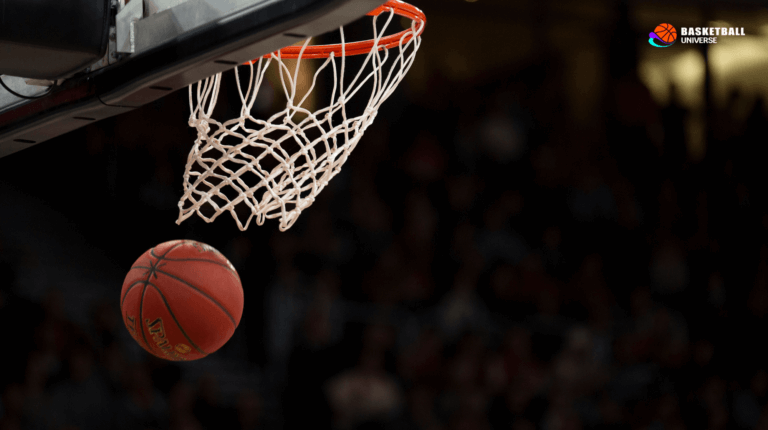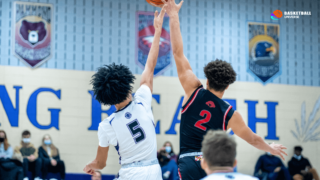
How Many Basketball Courts Fit in a Football Field?
Written by: Basketball Universe
Last updated:

Have you ever looked at a football field and wondered how many basketball courts could fit inside? You’re not alone! As sports enthusiasts, we too have been intrigued by this question, eager to satisfy our curiosity. In today’s blog post, we’re diving into the intriguing world of dimensions, comparing these two iconic sports venues to uncover the answer to this fascinating query. So lace up your sneakers, grab your measuring tapes, and join us on this delightful journey through the realm of sporting spaces!
How Many Basketball Courts Fit in a Football Field?
Approximately 9.8 basketball courts can fit in a football field. However, this number is based on the average dimensions of typical basketball courts (94 ft by 50 ft) and football fields (360 ft by 160 ft). Keep in mind that dimensions may vary depending on the level of play and facility standards.
Crunching the Numbers: Dimensions and Measurements
To begin our in-depth exploration of how many basketball courts fit in a football field, we first need to establish the standard dimensions for both types of sporting venues. The dimensions of a basketball court and a football field can vary depending on the level of play, country, and facility standards. However, for simplicity, we will refer to the most common measurements for professional games in the United States.
Basketball Courts
The standard dimensions of a professional basketball court – such as those used in the NBA – are 94 feet (28.65 meters) long by 50 feet (15.24 meters) wide, totaling 4,700 square feet. In comparison, collegiate and high-school-level basketball courts are usually 84 feet (25.6 meters) long by 50 feet (15.24 meters) wide, covering 4,200 square feet (390.2 square meters).
Football Fields
For football fields, like those used in the NFL, the dimensions are 360 feet (109.7 meters) long by 160 feet (48.8 meters) wide, which translates to 57,600 square feet (5,351 square meters) of playing area. It’s important to note that these measurements exclude the end zones, which are an additional 30 feet (9.1 meters) deep on each side of the field. Including the end zones, the total area of a standard football field is 70,800 square feet (6,582 square meters).
Calculating the Ratio of Basketball Courts to Football Fields
Now that we have a clear understanding of the dimensions for both basketball courts and football fields, let’s calculate how many basketball courts can fit in a football field. To do this, we’ll divide the total area of the football field by the total area of the basketball court. Using the professional-level dimensions for our calculations, we’ll consider the playing areas of these venues, excluding end zones for football fields.
Professional-Level Comparisons
First, we’ll use the professional NBA and NFL dimensions:
Football field area (excluding end zones) = 57,600 sq ftBasketball court area = 4,700 sq ft
Now, we’ll divide these numbers to find out how many basketball courts fit in a football field.
Number of basketball courts = 57,600 sq ft / 4,700 sq ft = 12.26
So, around 12.26 professional basketball courts can fit into an NFL football field as defined by the playing area. Keep in mind that these calculations are only approximations of the actual number of basketball courts that can fit because we are not considering barriers, player benches, or the extra space needed between the courts for safety.
College and High-School-Level Comparisons
Let’s take a look at how many college and high-school-level basketball courts can fit in a standard football field.
Basketball court area = 4,200 sq ft
We’ll perform the same calculations as before:
Number of basketball courts = 57,600 sq ft / 4,200 sq ft = 13.71
This means that approximately 13.71 college or high-school-level basketball courts can fit into an NFL football field (excluding end zones).
Factoring in Unique Court Layouts and Variations
While these calculations provide a general idea of how many basketball courts can fit in a football field, the actual number can vary based on design and layout. Below, we delve into how different court layouts and configurations might influence the total number of courts that can fit within the confines of a football field.
Maintaining Regulation Dimensions
If you plan to fit multiple regulation-sized basketball courts into a football field, you must take into account any additional space needed for adequate separation, spectator seating, and player benches. This extra space will decrease the number of courts that can fit within a standard football field compared to our initial calculations.
Using End Zones as Additional Space
If you decide to utilize the area within the end zones, you will increase the total available space in which basketball courts can be placed. Incorporating these areas could yield different results, allowing for more basketball courts to fit within the overall space of the football field.
Adjusting Court Dimensions
Modifying the dimensions of the basketball courts to fit smaller recreational or youth-sized courts could significantly impact the number of courts that can fit into a football field. Smaller court dimensions make it possible to place a higher number of courts in the same space, maximizing the area’s use and functionality.
Not Just a Number Game: The Significance of Understanding Space
When it comes to determining how many basketball courts fit in a football field, it’s easy to get caught up in dimensions and numerical calculations. However, the significance of understanding space requirements for sporting events goes beyond statistical satisfaction.
Venue Planning and Flexible Use
Having a clear understanding of the space requirements and measurements can help event organizers plan and design effective, functional venues that maximize the use of available area. Designing spaces to accommodate multiple sports and events is a practical approach that allows for seamless transitions between activities, all while streamlining facility maintenance and management.
Maximizing Athletic Participation
A sports complex that can host both basketball and football events in the same location encourages increased athletic participation by providing a convenient hub for a diverse range of sports enthusiasts. This can result in a stronger sense of community, help alleviate overcrowding in separate facilities, and promote a variety of healthy recreational activities.
Understanding Sporting Logistics
Developing an appreciation for how basketball courts can fit in a football field provides insights into the logistics that are integral to managing sporting events. From designing practice facilities to organizing large-scale tournaments, understanding the relationship between different playing surfaces is critical to sports administration and management.
To Sum It Up
Calculating how many basketball courts fit in a football field depends on several factors, including the level of play and the specific dimensions of each facility. Using standard professional dimensions, approximately 12.26 NBA basketball courts can fit in an NFL football field, while around 13.71 college or high-school courts can be accommodated.
Beyond these calculations, it’s essential to consider other factors such as additional space for barriers and seating, as well as variations in court dimensions and layout. Ultimately, understanding the relationship between basketball courts and football fields teaches us more than simple numerical comparisons – it broadens our knowledge of space utilization, event organization, and fosters a deeper appreciation for the complexity of sports facilities and management.
Arranging Basketball Courts Inside a Football Field
To optimize space and maximize the number of basketball courts fitting within a football field, one can consider various arrangement strategies. In this section, we explore some popular configurations that could effectively accommodate basketball courts while maintaining their functionality and safety standards.
Row-Based Arrangement
A common and efficient way to arrange basketball courts within a football field is to place them in rows. Depending on the facility’s specific dimensions, organizers could strategically accommodate multiple basketball courts by aligning them side by side (horizontally) or end to end (vertically). This configuration allows for a neat, structured, and easy-to-navigate layout that facilitates smooth transitions between games and events.
Compact Configuration
When maximizing the use of space is the top priority, a compact configuration might be the best solution. In this setup, basketball courts are organized closely together, with minimal empty areas between them. This layout might require organizers to make adjustments, such as reducing court dimensions, modifying seating arrangements, or limiting the availability of buffer zones to accommodate more courts within the available space.
Hybrid Arrangement
For facilities looking to provide a mix of recreational and competitive opportunities, a hybrid arrangement could serve as the ideal solution. This configuration incorporates different court sizes and styles within a football field, catering to varying levels of play, skill sets, and preferences. With a careful design approach and strategic planning, this type of setup can provide users with a diverse and inclusive space to accommodate multiple age groups and athletic interests.
Transforming a Football Field: Considerations for Hosting Basketball Events
Converting a football field into a basketball event space involves more considerations than simply calculating the number of courts that can fit within the boundaries. It’s essential to consider the following factors to ensure a smooth and successful transition:
Surface and Flooring
Football fields consist largely of grass, turf, or artificial surfaces. These materials don’t provide the necessary grip, bounce, or comfort required for playing basketball. Therefore, it’s crucial to install temporary, modular basketball court flooring systems that offer suitable performance characteristics for the athletes while protecting the underlying football field surface.
Player and Spectator Safety
When hosting basketball events in a football field, it’s essential to guarantee the safety of players, officials, and spectators. This involves adequately spacing courts, providing designated buffer zones and barriers, and ensuring that stages and seating arrangements comply with safety regulations.
Accessibility and Flow
Properly planned access routes and clear wayfinding signs for players, staff, and spectators are vital for maintaining smooth and seamless events. Thoughtful planning and design can contribute to a positive and enjoyable experience for all in attendance.
Weather and Outdoor Elements
Most football fields are outdoors, making them vulnerable to weather elements such as rain, wind, and direct sunlight. When organizing basketball events, be aware of how weather factors may impact playability, player safety, and spectator comfort. Installing temporary shelters or tents for seating areas or reserving alternate, indoor venues in case of severe weather conditions are smart precautions to consider.
Innovative Sports Facility Ideas
The concept of fitting basketball courts within a football field showcases the growing trend of designing versatile and adaptable athletic facilities. These innovative spaces can offer numerous benefits and inspire creative ways to plan and host sporting events.
Multi-Sport Facilities
Developing multi-sport facilities is an efficient approach to maximize space usage and investment while catering to a diverse audience. Such complexes can host various recreational activities, tournaments, and leagues across different sports, making them a hub of activity and promoting physical fitness among community members.
Reconfigurable Stadiums
Designing sports stadiums and arenas that can be easily reconfigured provides a flexible solution for hosting events of various scales and types. Through the use of movable seating sections, retractable panels, and modular flooring systems, these spaces can quickly transition from hosting basketball games to accommodating football matches and even concerts or large-scale gatherings.
Eco-Friendly Sports Facilities
As sustainability becomes an increasingly important factor in urban planning and architectural design, eco-friendly sports facilities offer a responsible and innovative approach to structure and function. Incorporating energy-efficient lighting systems, utilizing renewable materials, and implementing water conservation strategies are just a few examples of how facilities can reduce their environmental impact while providing enjoyable sporting spaces.
Ultimately, understanding how many basketball courts can fit in a football field is only the beginning of a much larger conversation around innovative facility design
FAQ: Understanding Basketball Courts and Football Fields
In this FAQ section, we address some of the most common questions related to basketball courts, football fields, dimensions, and multi-sport venues. By exploring these questions and answers, readers can deepen their understanding of the various intricacies concerning these two sporting venues.
1. How large is an NBA basketball court in meters?
An NBA basketball court measures 28.65 meters in length and 15.24 meters in width.
2. What is the size of a college or high-school basketball court?
College and high-school basketball courts typically measure 25.6 meters in length and 15.24 meters in width.
3. How big is an NFL football field in meters, including end zones?
An NFL football field, including end zones, measures 120 yards (109.7 meters) long and 53⅓ yards (48.8 meters) wide.
4. Are there regulations for the space between multiple adjacent basketball courts?
There are no strict regulations for the space between multiple adjacent basketball courts, but it’s recommended to leave a buffer zone of at least 10-15 feet for safety and ease of movement.
5. How can I convert a grass football field into a temporary basketball court?
To convert a grass football field into a temporary basketball court, install modular sport flooring systems designed for basketball use, provide appropriate markings and equipment, and consider additional seating and wayfinding requirements for spectators.
6. Can a single sports facility host both basketball and football leagues?
Yes, a single sports facility can host both basketball and football leagues, provided ample space and resources are available to cover the demands of both games, including field requirements, seating capacities, and maintaining functional transitions between events.
7. How do I prepare a football field to host wheelchair basketball events?
To prepare a football field for wheelchair basketball events, install adaptive basketball court flooring systems, provide adequate markings and equipment, ensure accessible routing and seating for athletes and spectators, and consider other specific needs and requirements for accessibility and comfort.
8. What are the standard dimensions for indoor and outdoor basketball courts?
The standard dimensions for both indoor and outdoor basketball courts are the same: 28.65 meters long by 15.24 meters wide for NBA courts, and 25.6 meters long by 15.24 meters wide for college and high-school courts.
9. What materials are used for temporary basketball court flooring?
Temporary basketball court flooring typically consists of modular tiles made from high-performance materials such as polypropylene or rubber, designed to provide proper grip, traction, and shock absorption.
10. How do I calculate the total area of a specific basketball court or football field?
To calculate the total area of a basketball court or football field, multiply the length by the width (measured in the same unit, such as feet or meters), which will give you the total area in square units.
11. Can soccer fields be converted into basketball courts?
Yes, soccer fields can be converted into basketball courts by installing modular flooring systems and providing appropriate markings and equipment. However, due to the larger dimensions of soccer fields compared to football fields, more basketball courts can potentially fit within the available space.
12. What factors should I consider when designing multi-sport facilities?
When designing multi-sport facilities, consider factors such as the dimensions and requirements of each sport, available space, access routes, seating arrangements, the frequency and scale of events, and the versatility of the venue for other community activities.
13. Can fans watch basketball games held on a football field without any visibility issues?
Fans can typically watch basketball games held on a football field without visibility issues if proper seating and wayfinding arrangements are put in place. However, organizers should consider factors such as sightlines and distance to ensure an enjoyable viewing experience for spectators.
Featured Posts
- No pillar pages found.





